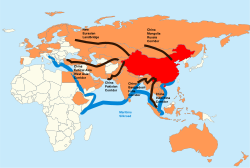Belt and Road Initiative
The Belt and Road Initiative (BRI), also known as the New Silk Road, is a plan by the government of the People's Republic of China to build infrastructure for transportation, from China to other countries in Asia, Europe, and Africa.[1] The project was announced in 2013. The "Belt" means the roads and railway tracks on land.[2] The "Road" means sea routes.[2]
At first, it was called "One Belt, One Road" (OBOR, Chinese: 一帶 一路 / 一带 一路, pinyin: Yidai Yilu).[3]
A high-speed railway in Thailand is part of OBOR; the Bangkok-Phitsanulok High-Speed Railway is under construction (as of 2017).
The idea has always had its critics. There has been criticism about human rights violations and environmental impact. In the main, the critics do not expect most recipient countries to pay China back. In many cases there is not the slightest chance of repayment. Secondly, some (many?) of the railways are quite obviously "railways to nowhere". This is clearest in Africa.[4]
"Some 150 countries have signed on to the Belt and Road with China, including 22 in Latin America", media said (2024).[5]
Member countries in Europe, includes Hungary, Slovakia and Serbia.[6]
Belt And Road Initiative Media
The Belt and Road initiative. China in red. Members of the Asian Infrastructure Investment Bank in orange.
Canopy of the main railway station in Novi Sad, Serbia, after the Novi Sad railway station canopy collapse
Poland's Prime Minister Beata Szydło and China's paramount leader Xi Jinping during meeting, 2016
Russian President Vladimir Putin and the Chinese leader Xi Jinping on 4 February 2022
Related pages
References
- ↑ Sausmikat, Nora; Noesselt, Nele. "Alte Seidenstrasse in neuem Gewand. Chinas Globalisierungsoffensive" (PDF). Stiftung Asienhaus (in Deutsch). giga-hamburg.de. Archived from the original (PDF) on 2017-07-02. Retrieved 2017-05-07.
- ↑ 2.0 2.1 Kuo, Lily; Kommenda, Niko. "What is China's Belt and Road Initiative?". the Guardian. Archived from the original on 2018-09-05. Retrieved 2019-04-09.
- ↑ "BRI Instead of OBOR – China Edits the English Name of its Most Ambitious International Project". liia.lv. July 28, 2016. Archived from the original on February 6, 2017. Retrieved August 15, 2017.
- ↑ Brautigam D. 2020. A critical look at Chinese 'debt-trap diplomacy': the rise of a meme. Area Development and Policy. 5 (1): 1–14. doi:10.1080/23792949.2019.1689828. S2CID 214547742
- ↑ https://www.bangkokpost.com/business/general/2727425/china-widens-south-america-trade-highway. Retrieved 2024-01-20
- ↑ https://www.nettavisen.no/norsk-debatt/kina-spiller-smart-hvordan-de-utnytter-europas-splittelse/o/5-95-2304287. Retrieved 2025-02-26








